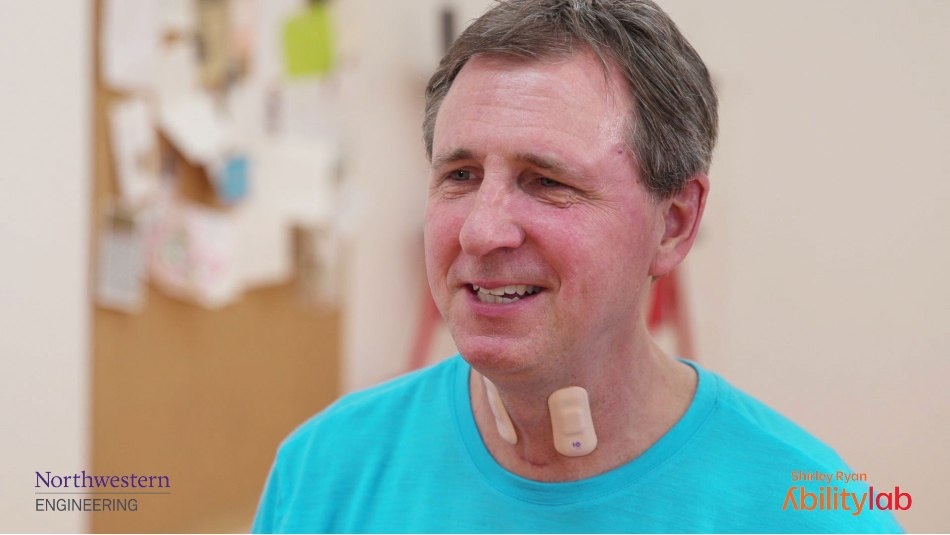Feb 19 2018
An innovative new wearable built to be worn on the throat could be a crucial turning point in the field of stroke rehabilitation.
 The throat sensor is designed to minimize irritation on sensitive skin. It measures patients' swallowing ability and patterns of speech. (Credit: Northwestern Engineering Shirley Ryan AbilityLab)
The throat sensor is designed to minimize irritation on sensitive skin. It measures patients' swallowing ability and patterns of speech. (Credit: Northwestern Engineering Shirley Ryan AbilityLab)
Created in the lab of Northwestern University engineering professor John A. Rogers, in collaboration with Shirley Ryan AbilityLab, the sensor is the newest in Rogers’ growing collection of stretchable electronics that are sufficiently precise for use in advanced medical care and sufficiently portable to be worn outside the hospital, even during strenuous exercise. Rogers presented the research on the connotations of stretchable electronics for stroke recovery treatment Saturday, February 17th, at the American Association for the Advancement of Science (AAAS) annual meeting in Austin, Texas.
Rogers’ sensors stick directly to the skin, moving with the body and providing comprehensive health metrics including muscle activity, heart function, and quality of sleep.
Stretchable electronics allow us to see what is going on inside patients’ bodies at a level traditional wearables simply cannot achieve. The key is to make them as integrated as possible with the human body.
John A. Rogers, Engineering Professor, Northwestern University
Rogers’ new bandage-like throat sensor measures patients’ patterns of speech and swallowing ability. The sensors help in the diagnosis and treatment of aphasia, a communication disorder linked with stroke.
The tools that speech-language pathologists have traditionally used to observe patients’ speech function – such as microphones – cannot differentiate between patients’ voices and ambient noise.
Our sensors solve that problem by measuring vibrations of the vocal cords. But they only work when worn directly on the throat, which is a very sensitive area of the skin. We developed novel materials for this sensor that bend and stretch with the body, minimizing discomfort to patients.
John A. Rogers
Shirley Ryan AbilityLab, a research hospital in Chicago, uses the throat sensor along with electronic biosensors – also created in Rogers’ lab – on the arms, legs, and chest to track stroke patients’ recovery progress. The intermodal system of sensors streams data wirelessly to clinicians’ computers and phones, providing a quantitative, full-body picture of patients’ advanced physiological and physical responses in real time.
“One of the biggest problems we face with stroke patients is that their gains tend to drop off when they leave the hospital,” said Arun Jayaraman, research scientist at the Shirley Ryan AbilityLab and a wearable technology expert. “With the home monitoring enabled by these sensors, we can intervene at the right time, which could lead to better, faster recoveries for patients.”
Since the sensors are wireless, they remove the barriers posed by traditional health monitoring devices in clinical settings. Patients can wear them even after they are discharged from the hospital, allowing doctors to be aware of how their patients are functioning in the real world.
Talking with friends and family at home is a completely different dimension from what we do in therapy. Having a detailed understanding of patients’ communication habits outside of the clinic helps us develop better strategies with our patients to improve their speaking skills and speed up their recovery process.
Leora Cherney, Research Scientist, The Shirley Ryan AbilityLab
Jayaraman describes the system’s mobility as a “game changer” in rehabilitation outcomes measurement.
Data from the sensors will be posted in a dashboard that is easy for both clinicians and patients to comprehend. It will transmit alerts when patients are underperforming on a specific metric and allow them to fix and track progress toward their goals.
“We are so grateful for our partnership with the Shirley Ryan AbilityLab,” Rogers said. “They are helping us move our technology from the research lab to the real world, where it already is making a positive impact on the lives of patients.”
Rogers also is partnering with the Shirley Ryan AbilityLab to test the sensors on patients with other conditions, such as Parkinson’s disease.
Bringing Sensors to Stroke Rehabilitation (with expert interviews)
(Credit: Northwestern Engineering)